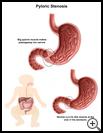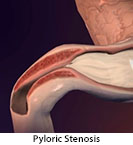
Pyloric Stenosis
What is pyloric stenosis?
Pyloric stenosis is a problem with the lower part of a baby’s stomach. The muscle of the lower part of the stomach (called the pylorus) gets too large and blocks the passageway into the small intestine. This makes it hard for the baby to keep food down.
Another term for this problem is gastric outlet obstruction.
What is the cause?
Normally, the muscle at the end of the stomach tightens to keep food in the stomach and then relaxes to let food out of the stomach and into the intestines. When a child has pyloric stenosis, the muscle is much bigger than normal and doesn't relax well. Why the muscle gets large and doesn’t relax well is not known.
Firstborn boys are more likely to have this problem. It also tends to run in families.
What are the symptoms?
Symptoms of pyloric stenosis usually start around 3 weeks of age. They may include:
- Vomiting that is forceful and frequent. The vomit may shoot across the room several feet. This is called projectile vomiting. The baby is usually hungry again right after vomiting.
- Small or infrequent bowel movements, green diarrhea, or mucus in bowel movements
- Dry lips and skin from losing too much fluid
- Weight loss or no weight gain
- Waves that you can see move across the baby’s belly just before vomiting
The symptoms of pyloric stenosis may be mild at first. Talk to your healthcare provider if your baby is spitting up often.
How is it diagnosed?
Your child’s healthcare provider will ask about your child's symptoms and medical history and examine your child. Your child may have tests to check for pyloric stenosis and other problems. Tests may include:
- An ultrasound, which uses sound waves to show pictures of the baby's stomach
- Blood tests
If the ultrasound does not clearly show the problem, your baby may need other tests or scans to find what is causing your child’s symptoms.
How is it treated?
Your baby will need surgery to loosen the muscle so that food will be able to pass more easily into the small intestine.
Babies can usually eat soon after the surgery.
How can I take care of my child?
Follow your child’s healthcare provider's instructions. Ask your provider:
- How and when you will get your child’s test results
- How long it will take for your child to recover
- How to take care of your child at home
- What symptoms or problems you should watch for and what to do if your child has them
Make sure you know when your child should come back for a checkup.
Last modified: 2016-03-23
Last reviewed: 2017-04-11


